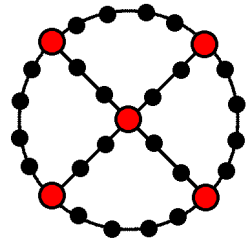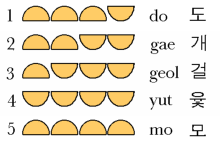Medieval Baltic


Games and Pastimes
Yut (윷)
Yut is a board game, that is generally considered ancient, but is definitely known in the 16th century.
I have been unable to find information about the history of the rules, and if they have changed over the centuries, so the rules described below are the 'simple' Yut rules.
Equipment
A game of Yut requires the game board, 4 binary dice, and 2 lots of 4 counters.
The Gameboard (Mal-pan, 말판).
The writer Gim Munpyo, in the 16th century, described the symbolism of a Yut board as symbolising the circle of the cosmos, with the North Star in the centre, surrounded by 28 constellations (Yi et al. 2006; 22-3). This differs from the modern, square boards that you can purchase cheaply today.

Possible shape of a 16th century Yut board (mal-pan, 말판).
Click on image to enlarge.
Binary Dice (Jang-jak, 장작).
There is also variation in the playing pieces and binary dice (for want of a better description) used, however once again I have not been able to find information about if and how these have changed over time. These four 'binary dice' are halved sticks, where the flat side equals '1' and the rounded side '0'. The exception is when all four jang-juk land curved-side up, which equals '5'.
The total number thrown indicates how many spaces on the board one of your playing pieces can advance.
How to count.

Summary of how to count in Yut. On the left is the number of points, followed by a schematic representation of the Jang-jak. On the right is the name of this particular throw, both in romanized and Korean form.
Copied from its' Wikipedia page.
As in the drawing above, each throw has a special name, and they revolve around livestock.
1 is do (도) meaning pig,
2 is gae (개) meaning dog,
3 is geol (걸) meaning sheep,
4 is yut (윷) meaning ox,
5 is mo (모) meaning horse.
The apparent astronomical symbolism of the binary dice has been described by Park (2008; 159-60). The number of jang-jak are four, symbolising the earth, while the maximum number of spaces that can be moved is five, representing the heavens. This corresponds to the round outline of the board indicaking the sky, and the crossed centre the square earth. Although, if this symbolism is traditional but modern, or a fundamental part of the game throughout its' history is not clear.
Counters (Mal, 말)
8 tokens in total, that can be easily identified and divided into belonging to the two opposing teams. For example, four may be coloured red, while the other four are blue. To continue the animal theme, 'mal' means 'horse' as you will want counters that can race quickly around the board.
A Modern Concession...
If you're playing anywhere that isn't outdoors or thickly carpeted, a small pillow to throw the jang-jak on may be a good idea, since it can be quite loud. :)
How to Play
The aim of the game is to move all of your teams' counters around and off the board, before the opposition can. After throwing the jang-juk sticks, one of the counters can be moved that number of places around the board. The usual starting point is the bottom right-hand intersection. When a player lands on an intersection, a choice in direction can be made to 'shortcut' the corners.
If a counter lands on an opponents' piece, then the opponents' counter is moved back to the starting place. If your turn ends on one of your own counters, then they can travel as a single piece from that point on. However, if a counter from the other team lands on this group, then all of your counters have to move back to the start to begin again.
Sources
- Jung Jin Art How to Play Yute [Game Instructions]
- Park, Changbom. Astronomy: Traditional Korean Science. (Seoul: Ewha Womans University Press, 2008.)
- Wikipedia Yut
Page last Accessed 3rd February, 2009. - Yi I-Hwa, Lee E-Wha and Park, Ju-Hee Korea's Pastimes and Customs: A Social History (Homa & Sekey Books, 2006)
